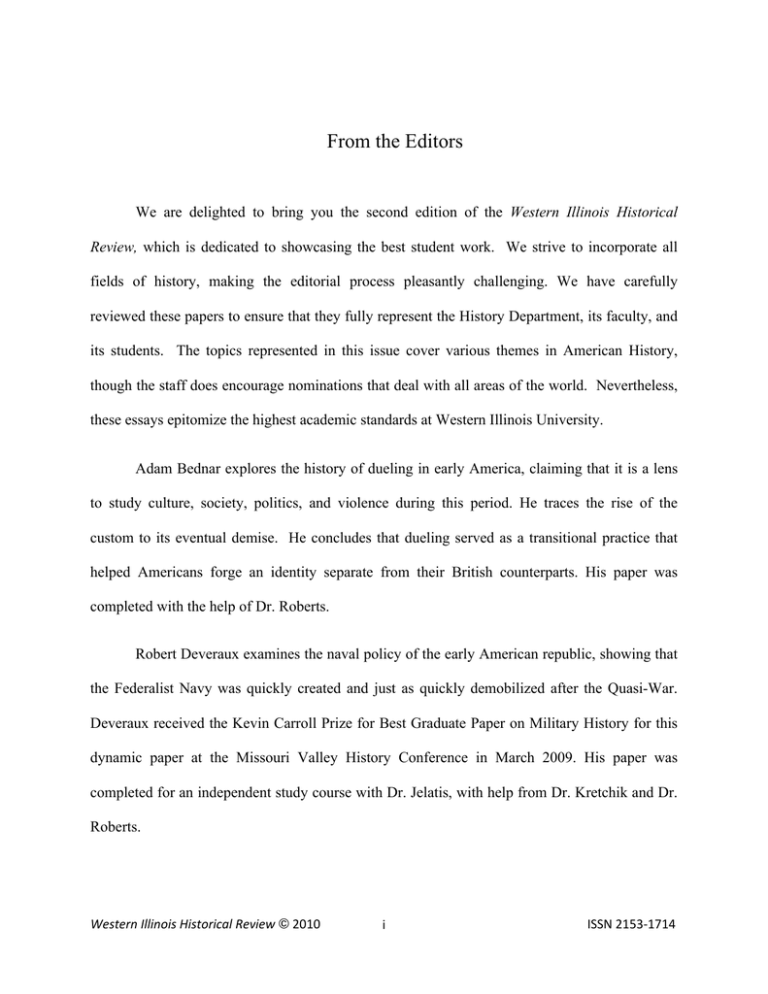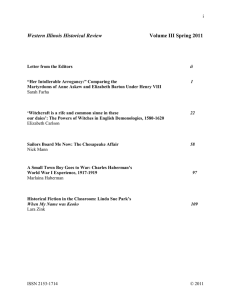From the Editors
advertisement

From the Editors We are delighted to bring you the second edition of the Western Illinois Historical Review, which is dedicated to showcasing the best student work. We strive to incorporate all fields of history, making the editorial process pleasantly challenging. We have carefully reviewed these papers to ensure that they fully represent the History Department, its faculty, and its students. The topics represented in this issue cover various themes in American History, though the staff does encourage nominations that deal with all areas of the world. Nevertheless, these essays epitomize the highest academic standards at Western Illinois University. Adam Bednar explores the history of dueling in early America, claiming that it is a lens to study culture, society, politics, and violence during this period. He traces the rise of the custom to its eventual demise. He concludes that dueling served as a transitional practice that helped Americans forge an identity separate from their British counterparts. His paper was completed with the help of Dr. Roberts. Robert Deveraux examines the naval policy of the early American republic, showing that the Federalist Navy was quickly created and just as quickly demobilized after the Quasi-War. Deveraux received the Kevin Carroll Prize for Best Graduate Paper on Military History for this dynamic paper at the Missouri Valley History Conference in March 2009. His paper was completed for an independent study course with Dr. Jelatis, with help from Dr. Kretchik and Dr. Roberts. Western Illinois Historical Review © 2010 i ISSN 2153‐1714 Matt Bruning claims that the Union was never completely unified during the Civil War. Using a case study of Franklin County, Pennsylvania to prove his thesis, Bruning shows that Franklin County differed from most of the Union due to its location, political leanings, and wartime experiences. His paper was completed under the guidance of Dr. Roberts. Bridget Quinlivan uses the magnificent architecture of Quincy, Illinois as a case study to show that this community’s changing values are reflected in its architecture. Quinlivan’s paper covers the importance of architecture in the Victorian Era for the city and explores Quincy’s dedication to maintaining its rich architectural heritage while also keeping up with modernity. Her paper was completed for Dr. Hall. Ryan Buller explores the political downfall of Mayor Carter Henry Harrison. Buller states that historians have long focused on just one factor that brought his demise, but he claims Harrison’s withdrawal was due to three factors that worked together to turn down the Democratic nomination for Mayor in 1887. Ryan completed his paper with help from Dr. Hall. Finally, Austin Schwartz examines the ill-prepared leadership of junior officers during World War I. Schwartz states that the senior officers have often been blamed for the poor performance of the military on the Western Front, but it was the junior officers who demonstrated weaknesses in their pre-war training. Austin completed his paper with Dr. Kretchik. The editorial board worked diligently to bring this second volume to fruition. The inaugural issue of the journal was well received and recognized by the Library of Congress, and we hope to continue to pass along our passion for history and historical inquiry. Enjoy these Western Illinois Historical Review © 2010 ii ISSN 2153‐1714 papers which represent the utmost dedication and scholarship by students here at Western. Thank you for taking the time to visit the Western Illinois Historical Review. Sarah Garmer and Bridget Quinlivan Co-Editors, Western Illinois Historical Review Western Illinois Historical Review © 2010 iii ISSN 2153‐1714



